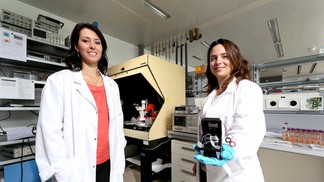May 11 2015
With certain critical treatments, personalised care includes the ability to monitor the concentration of medicines in the patient's body, in order to adjust the treatment. Researchers at EPFL have come up with a quick and portable new device for measuring the amount of medicinal drugs in blood. Doctors and pharma companies have already expressed interest in this research.
 © 2015 EPFL/Alain Herzog
© 2015 EPFL/Alain Herzog
We are not all equal when it comes to either sickness or medicines treatments prescribed by doctors. Some patients absorb or eliminate active substances quickly, while others do so more slowly. For a treatment to be effective, the amount of medicines prescribed needs to be customised. Too high of a dose can trigger adverse effects, while an insufficient dose will lack efficacy. But how can we know how much of the active ingredient of a medicine circulates in a patient?
Aptamers, stars in the detection of medicines
The first step consists of identifying the concentration of medicines in the body, which is not easy. At EPFL, researchers in Carlotta Guiducci's Lab - Swiss Up Engineering Chair (CLSE) have developed a rapid and low-cost method to produce DNA fragments called aptamers, which are effective at capturing medicinal drugs in a blood sample. Aptamers represent a promising and underexploited technique in the detection of medicines. They are robust and stable and better suited than antibodies, which are often too large to detect small molecules efficiently. There is one hitch, however: the production of aptamers is currently slow and expensive.
Recently published on the cover of ACS Combinatorial Science, a new method will pave the way towards the easy selection of aptamers that do not yet exist and that could react with new kinds of medicine. "As of today, aptamers are selected by a small number of specialised laboratories, and they only fit for a limited number of target molecules", says Carlotta Guiducci, director of the CLSE.
Here's how it works. The researchers attach DNA fragments to magnetic beads. When the target molecule approaches, the most receptive fragments go off the bead and cling to the molecule. The best fragments are then purified, multiplied and tested again, in order to eventually select the top performer. Only a few cycles of selection were necessary to obtain an aptamer at least as effective as those produced via traditional methods.
New approach to drug quantification
The researchers did not stop there. Working with the CHUV (the University Hospital of Lausanne), they tested their aptamers using their compact new optical detection method, featured in Analytical Chemistry. For their test, the researchers chose to detect an antibiotic called tobramycin, which is currently used for hospital treatment of some infections.
"We used blood samples of known tobramycin concentration, measured with the reference methods at CHUV. The goal was to check whether our aptamers, combined with this simple and inexpensive sensor, were accurate in measuring the level of the medicine," said Carlotta Guiducci.
The sensor, which fits into the palm of the hand, is made up of an LED light, a microfluidic device and a CMOS video camera. Inside the microfluidic channel are gold nanoislands with aptamers attached. When the sample enters the tube, the target molecules cling to the aptamers, which modifies optical properties of the contact surface, making it possible to determine the concentration of the drug in the sample. "The concentration of tobramycin that we determined using our method corresponded to the clinical requirements," says the researcher. "All indications are that this method could also work for many other types of medicines."
Easy way to monitor medicines in the blood
By virtue of these joint research projects, the researchers have come up with a fast, inexpensive and compact turnkey technique for detecting medicinal substances in accordance with clinical requirements. In parallel, computer tools to assist in the interpretation of these measurements are being developed.
This will be of interest to doctors, who will be able to easily monitor the amount of medicines in their patients' blood, and to biotech and pharmaceutical companies. Debiopharm International, whose laboratory "Translational Laboratory" is located on the EPFL campus, contributed to this research through a Swiss Commission for Technology and innovation (CTI) project. "The companies would like to characterize active principles quickly and inexpensively during the drug development phases. They want to know how their products are absorbed and eliminated by the body, before bringing them to the market," says Carlotta Guiducci.